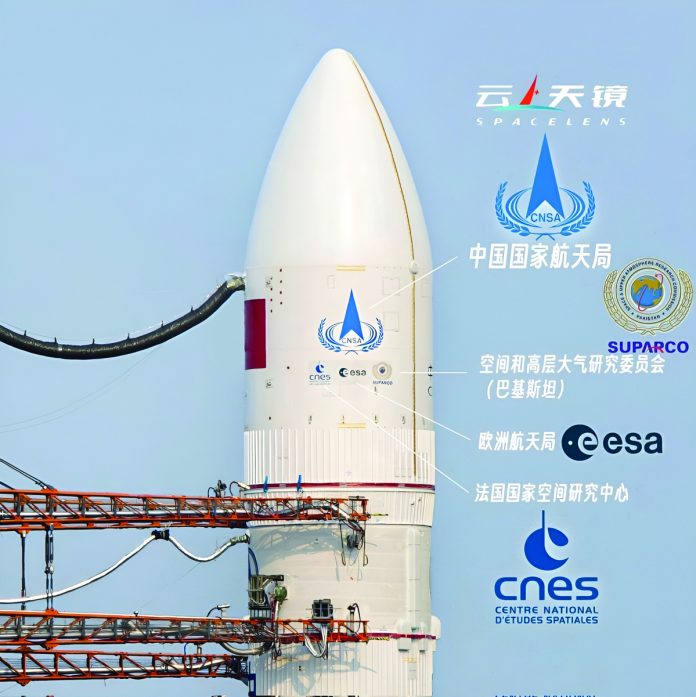Syed Samiullah
ICUBE-Q, also known as ICUBE-QAMAR, marked a historic milestone for Pakistan as it was the country’s first deep space mission. This pioneering Nano-satellite was developed specifically for lunar remote sensing, an advanced method of collecting information about the Moon without direct contact. Unlike traditional methods that require instruments to be physically placed at the observation site, remote sensing enables scientists to gather data from a distance, making it an essential tool for exploring celestial bodies like the Moon.
This mission was not just a standalone effort by Pakistan but a result of remarkable international collaboration. ICUBE-QAMAR was one of the four international payloads on board China’s prestigious Chang’e 6 lunar mission, which aims to return samples from the far side of the Moon something that has never been done before in human history.
Background
In 2019, the China National Space Administration (CNSA) extended an exciting invitation to the global scientific community: an opportunity to send lightweight payloads less than 10 kilograms aboard its upcoming Chang’e 6 lunar sample-return mission. This mission, aimed at collecting samples from the far side of the Moon and returning them to Earth, also included room for international collaboration. In 2022, CNSA announced that scientific instruments from France, Italy, and Sweden would be part of the lander, while a Pakistani payload would be onboard the orbiter, bringing a proud moment for Pakistan’s space ambitions.
Rising to the occasion, the faculty and students of the Institute of Space Technology (IST) submitted a proposal for a small but powerful lunar CubeSat, named ICUBE-Qamar (ICUBE-Q). Following a rigorous evaluation process, the satellite was officially selected to fly on the Chang’e 6 mission.
Development and launch
Fundamentally, the development of ICUBE-Q was a result of a healthy partnership between IST, Pakistan’s national space agency SUPARCO, and the Shanghai Jiao Tong University (SJTU) of China. While the initial design was carried out at IST’s Space Systems Laboratory, the actual development and integration took place at the Intelligent Satellite Technology Center at SJTU’s School of Aeronautics and Astronautics. Locally in China, the satellite is referred to as SJTU Siyuan 2.
The Nano-satellite was launched on May 3, 2024, from the Wenchang Space Launch Site aboard a Long March 5 Y8 rocket. Then only after five days of its launch, on May 8, 2024, at precisely 08:14 UTC (13:14 PKT), ICUBE-Q was successfully deployed from the lunar orbiter stack into space. After a series of onboard tests during the following days, the satellite transmitted its first images back to Earth on May 11, 2024, captured from an altitude of 200 kilometers above the Moon’s surface. Speaking to the media, Dr. Khurram Khursheed, spokesperson for the Institute of Space Technology (IST) and Head of the Department of Electrical and Computer Science, expressed pride in the achievement. “This is a moment of great honor and scientific achievement for Pakistan. The success of ICUBE-Q demonstrates our capability to contribute meaningfully to deep space exploration,” he stated. “Its surface-level analysis capabilities, transmitting images at a modest 1-kbps, will provide crucial data on crater locations, water, and traces of ice on the moon’s surface,” Dr. Khursheed added.
Objectives
The mission’s objectives go far beyond simply capturing images. ICUBE-Q is designed to carry out a range of advanced tasks, including capturing high-resolution imagery of the Moon’s surface and conducting intelligent on-orbit data processing to minimize transmission loads. Additionally, it aims to collect valuable data on the lunar magnetic field, contributing to the development of a comprehensive lunar magnetic field model. The mission also seeks to validate emerging technologies in deep space communication and demonstrate the viability of low-cost, nano-satellite-based exploration, setting the stage for future innovations in deep space missions.
Specifications
Designing and building a satellite capable of deep space exploration is an extraordinary engineering achievement, especially when operating under tight restrictions of size and weight. The ICUBE-Q satellite, weighing in at just 6.5 kilograms, is a prime example of how complex systems can be condensed into a compact form without compromising functionality or durability. Fitting all essential components such as the power supply, communication systems, and scientific instruments into such a small frame posed numerous technical challenges. The satellite had to be not only efficient but also exceptionally resilient to endure the tough environment of space, including gravitational fluctuations, intense radiation, extreme temperature changes, and even the unescapable lunar dust.
To meet the demands above, ICUBE-Q was outfitted with a range of advanced features. It incorporates multi-sensor fusion technology to enhance navigational accuracy, multi-layer radiation shielding to protect sensitive electronics, and sophisticated thermal control systems to maintain optimal operating conditions in the face of volatile space temperatures. The ICUBE-Q system itself is comprised of three main parts: the core satellite body, a separation mechanism that includes a power control box, and a sturdy mounting bracket. Additionally, it is powered by a 12-volt, 11.6 amp-hour battery (delivering 139.2 watts) and is supported by two solar panels that deploy once in orbit.
For communication and data handling, the satellite operates on X-band frequencies, managing telemetry, tracking, command (TT&C), and image transmission at a data rate of 1 kilobit per second. Its attitude control system ensures precise orientation using a combination of reaction wheels, Sun sensors, and a star tracker all of which contribute to three-axis stabilization. The satellite’s structure, built with lightweight yet strong materials like magnesium alloy and honeycomb carbon fiber, offers a perfect balance between durability and efficiency.
ICUBE-Q carries two visible-light cameras, each with a 1-megapixel resolution (1280×720), positioned on opposite sides of the satellite’s X-axis to maximize image capture. To enhance reliability and mission success, the satellite also includes intelligent onboard features such as automatic fault detection and a smart task scheduling system, allowing it to adapt and perform even in unpredictable situations.
Conclusion
Pakistan’s successful deployment of ICUBE-QAMAR, its first lunar CubeSat, signifies a significant step forward in the nation’s scientific and technological journey. The compact yet efficient design fulfills advanced scientific objectives, including imaging, data transmission, and studying the Moon’s surface and magnetic field. ICUBE-QAMAR serves as an inspiration for young scientists, engineers, and students, proving that ambitious goals like deep space exploration can be achieved with vision, collaboration, and perseverance.
The author is the head of the Research Department at Rabita Forum International (RFI) and the Associate Editor of the Monthly Interaction.







